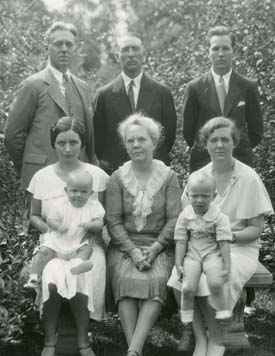 |
 |
| current issue |  | past issues |  | send a letter/news |  | address update |  | advertise |  | about us |  | alumni home |
Web Extras
The Kind of Man He WasPage 3 of 3
At the agricultural college, Lewis struck up what would be a lifelong friendship with another English professor, Robert Frost, and was the first to read one of Frost's poems at a public event, in 1916. The pair shared a love of baseball as well as poetry and would play "singles" baseball in the backyard whenever they got together. In fact, when Frost spoke at Lewis's memorial service, he said this about the connection between their shared interests:
He told me once ... that he began his interest in poetry as he might have begun his interest in baseball—with the idea of victory—the "Will to Win."
He was at an Eisteddfod [arts festival] in Utica, an American-Welsh Eisteddfod, where the contest was in poetry, and a bard had been brought in from Wales to give judgment and to pick the winner; and the bard, after announcing the winner and making the compliments which judges make, said he wished the unknown victor would rise and make himself known and let himself be seen. (I believe the poems were read anonymously.) The little "Ted" Lewis sitting there beside his father looked up and saw his father rise as the victor. So poetry to him was prowess from that time on, just as baseball was prowess, as running was prowess. And it was our common ground.

|
In 1927, Lewis left Amherst to become president of UNH. During his nine-year tenure, he is credited with the completion of several new buildings and the athletic fields later named for him. His administration also saw the establishment of sabbaticals for faculty members, retirement plans for faculty and staff, and higher admissions standards for students. During this period, his papers show, he knew and corresponded with many prominent Americans, including Presidents Coolidge, Taft , Wilson and Franklin Roosevelt; explorer Admiral Byrd and heavyweight champion Gene Tunney.
More memorable to Peg Van Allen are her impressions of family life in the big brick house. Van Allen had the opportunity to stay overnight there a number of times when she became friends with President Harold Stoke's daughter, Marcia, in the 1940s. Like her mother before her, Van Allen then got to know "all the little cubby holes and secret passageways," she says. "Marcia had a Scottie dog that she dressed up, and I had a cocker spaniel that I dressed up." But what struck her most, perhaps, was something under the dining room table: a button for calling the housekeeper. ("I'd never known anybody who had a button to call anyone," she recalls with amusement.)
Ted and Margaret Lewis also had a housekeeper in the president's house, of course, but she had Sundays off. "My grandfather expected my grandmother to have students in, about a dozen of them, every single Sunday night," Van Allen says. Her grandmother usually made her special chocolate cake—still a family favorite—and apparently Lewis efforts to get to know the students were a success. Clara Skoglund '38 later told Van Allen that Lewis knew every single student by name, and she almost fainted the first time he addressed her as Clara when passing by on the sidewalk. He is also known to have given an interest-free loan to at least one student who was on the verge of dropping out for lack of funds.
For Van Allen's parents, the president's house was a special place indeed. Her father, Sam Hoitt '28, who eventually became the director of UNH Cooperative Extension, grew up in a large farmhouse at 28 Mill Road, which is still standing today. (A number of UNH buildings on that side of campus, as well as the houses in the Faculty Roadneighborhood, were all built on land that originally belonged to the Hoitt Farm—and the house was later home to UNH art professor John Hatch and his family for many years). One of six children, he had a small upstairs bedroom from which he had a straight line of sight to the upper story windows of the president's house. When he was courting Lewis' daughter, Gwendolen, the pair used to communicate in code with flashlights from their respective bedrooms, says Van Allen, asking each other questions like, "Do you love me?" "How much?" Their wedding was held at the president's house in March 19, 1932. Three years later, President Ted Lewis was running up and down the sidewalk in his pajamas exclaiming about the birth of his new granddaughter.
Page: < Previous 1 2 3
Easy to print version

